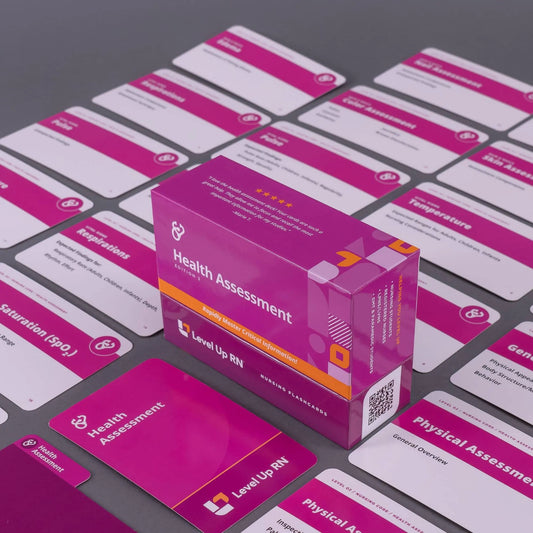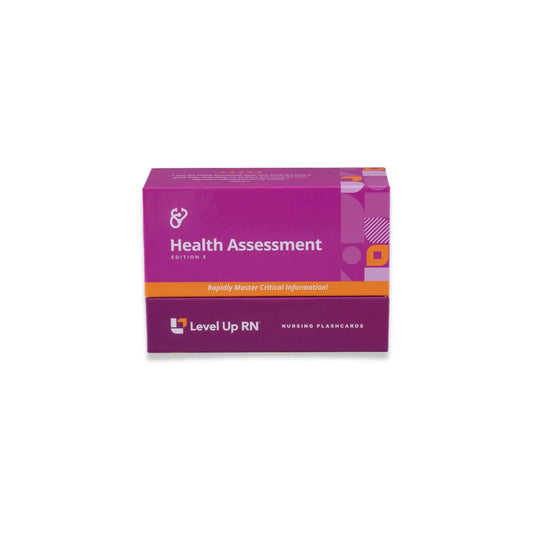Health Assessment, part 9: Orthostatic Vital Signs
Updated: Meris ShuwargerWhen and how to assess orthostatic vital signs, orthostatic hypotension criteria, and important patient teaching
Full Transcript: Health Assessment, part 9: Orthostatic Vital Signs
Full Transcript: Health Assessment, part 9: Orthostatic Vital Signs
Hi, I'm Meris. And in this video, I'm going to be talking to you about orthostatic vital signs, including what it is, when to assess it, the inclusion criteria for orthostatic hypotension, and some important patient teaching. I'm going to be following along using our health assessment flashcards. These are available on our website, leveluprn.com, if you want to grab a set for yourself. And if you already have a deck, I would invite you to follow along with me. All right. Let's get started. So first up, let's talk about when we would assess orthostatic vital signs. So orthostatic vital signs are where we're going to actually take the patient's blood pressure and pulse in three different positions: lying down, sitting, and then standing. And this is something that we would do, of course, any time it is ordered by the provider, but other indications that might prompt you to go ahead and do this even before you get the order would be if the patient says that they fainted or had what we call a syncopal episode. So they're walking around, and they passed out, or they stood up and they passed out would be a good time to get orthostatics. If they have hypovolemia, so if we know that they are dehydrated or experiencing some sort of hypovolemia, we may want to assess orthostatics. And then any time they're taking certain medications, if they're reporting any kind of an issue with that, specifically, medications that affect the blood pressure, like ACE inhibitors, we may want to go ahead and assess orthostatic vital signs.
Now, how do we do this? So we're going to assess orthostatics by having the patient lie supine. So lay on their back for at least five minutes before we begin. Then we're going to take their blood pressure and pulse. That's our first reading. Next, we're going to sit the patient upright. For instance, on the edge of the bed. We're going to wait two to three minutes. This is the portion that often gets missed by students and by nurses and clinical providers. Wait two to three minutes and then take their blood pressure and pulse while they're in the seated position. Then, we're going to have them stand up. And again, we're going to wait two to three minutes and we're going to take their blood pressure and pulse again. You as the nurse, you need to be watching and providing for safety. So if your patients getting really dizzy or weak, if they look like their legs are about to go out from underneath of them, we're not going to continue doing the orthostatics. We're going to stop. Provide for their safety. Have them sit down. We do not want them to fall and hurt themselves.
Now, let's talk about orthostatic hypotension criteria. Orthostatic hypotension. It's a very fancy way of saying, when I change positions, my blood pressure drops, okay? So that can be really bad because if I have a significant drop in my blood pressure, I will momentarily not perfuse my brain, which will then lead to me losing consciousness. And if I fall and I hit the ground, now I could have a big problem, like a head trauma, right? So very important that we know what this is and why it's a big deal. So two criteria here. Bold in red. You know what that means; you got to know it. So a drop in systolic blood pressure - that's that top number - of greater than or equal to 20 millimeters of mercury when changing positions and/or a drop in diastolic blood pressure greater than or equal to 10 millimeters of mercury when changing position. So that's that bottom number. So if either one of those happens, we're meeting orthostatic hypotension criteria. If both of them happen, we definitely are. So if my blood pressure drops a little bit, a couple of points, that that's kind of expected. That's not orthostatic hypotension. So if my blood pressure sitting, for instance, is, let's say, 120 over 80, and I stand up and it's 112 over 76, okay, it dropped a little bit, but not enough to meet that criteria. Now, if I stand up and my blood pressure is 96 over 60, that's orthostatic hypotension. Even if I don't pass out or get dizzy, I still meet that criteria.
Patient teaching. And you know or at least you should know, or you'll learn that patient teaching is really a whole lot of what's going to be on that nursing school exam or NCLEX for you because you need to know what to teach your patient and how to have them provide for their own safety. So change positions slowly. So we're not jumping out of bed like we're so excited to go do whatever it is. No, no, no. We're going to stop. We're going to sit up slowly, dangle our legs over the edge of the bed for several minutes before we attempt to sit up. All of these things will help us to decrease our risk for orthostatic hypotension and falls. We're going to have our patients increase their fluid intake because if we increase the volume in the pipes, we will increase the pressure. And then, call for help before ambulation. This is really important for your patients who are admitted to the hospital. We don't want you getting out of bed without calling for help. Please, please, please - what is it that we say? - call don't fall. So this may be applicable in their home environment as well, but it's just going to depend on the context of your patient.
All right. Let's go ahead and test your knowledge of key facts I gave you in this video using my quiz questions. In which position should the nurse have the patient when obtaining the final orthostatic reading? The patient should be standing. How long should the patient remain supine prior to beginning orthostatics? For at least five minutes. All right. That is it for this video. I hope that was a helpful review for you. If you've got any comments or feedback, I would love to hear them. And if you have a funny or unique way to remember something, please leave me a comment. I know that I want to hear it and so do other students. You're doing a really great job and I'm super proud of you. Thanks for studying with me.
True story. When I was 19 years old, I think, I actually had Rocky Mountain spotted fever. And who knew, who knew. I got bit by a tick, and I had Rocky Mountain spotted fever. I was not diagnosed for a while. It took a while for me to be diagnosed. But the reason that I ended up going to the emergency room was I kept waking up in the middle of the night feeling ill, and when I would get up out of my bed, I would then find myself on the floor. And what was happening was I was experiencing orthostatic hypotension, and I was passing out and hitting the floor before I could make it to the bathroom. That was actually the thing that prompted me to get help. And sure enough, they did orthostatics in the ER and on the inpatient floor, and I had a wild drop in my blood pressure when I would stand up. So it can have very serious ramifications for your patients. And again, in that instance, it told them, "This patient is really severely hypovolemic. Something isn't right." My orthostatics, even before they could diagnose what was wrong with me, it was enough to buy me an admission to the med surg floor.


